St. Martin and Aegidius (forest)
St. Martin and Aegidius is an Evangelical Lutheran church in the classicist margrave style in Wald , a district of Gunzenhausen in the Middle Franconian district of Weißenburg-Gunzenhausen ( Bavaria ).
location
The church is in the northeast on the outskirts of Wald. You can get to it on a cul-de-sac that ends soon after the church. The church area is surrounded by a wall.
Building history
A castle is mentioned in 1355 , which up to this point was owned by an Erkinger Truchseß von Wahrberg as a fiefdom of the Bishop of Würzburg. From a document two years younger we learn that St. Michael zu Wald, probably a chapel built by the Lords of Spielberg next to the moated castle, was a branch of the Gnotzheim parish up until then . The chapel, originally built in the middle of the 8th century as a Franconian mission church and rebuilt around 1100, was expanded in the late Gothic (15th century) or rebuilt as a church. The Reformation was introduced very early, 1527/28; the last Catholic pastor Siegmund Peuerlein († 1543) was also the first Protestant pastor and in 1533 enforced the Brandenburg-Nuremberg church order. In the Thirty Years' War , this church was destroyed.
Today's house of worship is due to the art-loving brothers Johann Wilhelm and Carl Friedrich von Zocha ; the Zocha family ruled in Wald since 1626 and were also owners of the patronage right. Reusing the late Gothic tower of the previous building, the margravial chief court building officer Carl Friedrich von Zocha (* 1683; † 1749) built a new church according to his own plans after demolishing the old church from 1722 to 1724, with its classicist simplicity with few baroque echoes in the furnishings "Highly idiosyncratic construction of this time". The tower was given an octagonal upper floor with a pointed helmet. With the new building, the cemetery was moved in front of the village.
As a successor to the von Zocha family, who died out with Carl Friedrich, the "Wild Margrave" Karl Friedrich Wilhelm von Brandenburg-Ansbach endowed his neighboring, newly ennobled son Friedrich Carl Freiherr von Falkenhausen with the fiefdom of the forest; the new ruling family built a family crypt under the church - not open to the public - which was first documented as such in October 1757 after the death of the ancestral mother of this family, the beautiful weaver's daughter Elisabeth Winkler from Leidendorf .
In 1928 the church, whose roof and ceiling had become dilapidated, was extended by 7.5 m by an annex to the west, so that the "old" church from the outside almost became a transept. The architect Buck in Nuremberg provided the plans. The new west facade with its triangular gable was adapted to the old, early classical west facade from 1722/24, a flight of stairs led and leads to the portal.
Building description
Before the extension, the church was a T-shaped transept with a retracted east tower, the foundations of which go back to the church from 1100. In front of the bricked-up former choir (today sacristy ) came the new pulpit wall. The square, 9.9 m high central room was spanned by a ridged cross vault. To the west, north and south, barrel-vaulted side arms with galleries were connected by round arches; the stairs to the side galleries were on the side in the narrow intermediate building between the tower made of stone blocks and the main building; the spiral staircase to the west gallery rose in the southern part of the old, short west wing. Today, differently curved and stone balustraded stairs lead to the side of the new extension from 1928 to the galleries. Behind the high arched window above the portal is the manorial box as a western gallery. The coat of arms of the Falkenhausen family, a falcon striding to the right, is painted in blue above the window.
The church has hipped roofs and rusticated corner pilaster strips.
Furnishing
Altar, pulpit and organ are arranged one above the other; the congregation should concentrate on the sermon and church music. The simple altar, surrounded by a dining grille with golden carvings, has an altar panel from 1792 that shows the risen Lord as he appears to the disciples. The pulpit with a figure of Christ as a good shepherd on the sound cover is little decorated, the organ in a low, recessed gallery has only a small amount of Rocailles decor on its three-part front. Today's organ was built by Plum in Marbach in 2002; it replaced an Oettingsche Steinmeyer organ from 1909.
A baroque baptismal font, carried by a putti, stands to the right of the altar, as a neo-Gothic baptismal font was placed in front of the altar in 1904 .
From the previous building come two well-drained wooden sculptures attached to the west walls of the side arms, depicting a holy bishop (perhaps Willibald von Eichstätt ) and St. Laurentius represent.
Bells
In 1937 the church had two bells, one cast around 1400, the other from 1418 (with a relief of the crucifixion scene). Today there are four bells.
Others
- In the church wall is a grave plaque of the Prussian Major General Voit von Salzburg (near Neustadt / Saale), who served as grenadier captain in the Seven Years' War and in the American War of Independence led the margravial regiments sold to England and died on May 14, 1798 in Wald.
- From the Walder parish family Bezzel came Dr. Hermann von Bezzel , * 1861, who became rector of the Neuendettelsau deaconess institution in 1891 and headed the Evangelical Lutheran Regional Church of Bavaria as senior consistorial president from 1909 . He was buried in Wald in 1917.
- "In church groups, we have the trombone and church choir, the senior circle, the women's circle, the rural youth, the flute choir, the mother-child group, children's gymnastics with Würmli as well as the children's church service helpers and over 50 volunteer workers." Parish was expanded by a second group around 1993.
Appreciation
"Among the numerous churches worth seeing in Altmühlfranken, the church in Wald stands out due to its external shape."
literature
- Karl Gröber and Felix Mader (editor): The art monuments of Middle Franconia. VI Gunzenhausen district office. Munich: R. Oldenbourg-Verlag 1937, esp. Pp. 284–287 (with images of the church before 1928).
- M [artin] Winter: Wald community . In: Landkreis Gunzenhausen , Munich, Assling: Publishing house for authorities and business RA Hoeppner, 1966, pp. 254-256.
- Robert Schuh: Gunzenhausen. Former district of Gunzenhausen . Series of Historical Place Name Book of Bavaria. Middle Franconia, Vol. 5: Gunzenhausen . Munich: Commission for bayer. Landesgeschichte 1979, pp. 325–327.
- FOREST Church of St. Giles (Evangelical Lutheran) . In: Werner Somplatzki: Churches in Altmühlfranken , Treuchtlingen: wek-Verlag 1990, pp. 10-12.
- Forest . In: Georg Dehio: Handbook of German Art Monuments. Francs. The administrative districts of Upper Franconia, Middle Franconia and Lower Franconia. Edited by Tilmann Breuer and others. Munich, Berlin: Deutscher Kunstverlag, 2nd, revised and supplemented edition, 1999, p. 1079 f.
- St. Martin & Aegidius Church in Wald. Leaflet, undated, undated (after 2003)
- Evangelical Luth. Church of St. Martin and Egidius . In: Johann Schrenk and Karl Friedrich Zink : God's houses. Church leaders in the district of Weißenburg-Gunzenhausen , Treuchtlingen: wek-Verlag, 2008, pp. 236–238.
- Heimatverein Wald-Streudorf (Hrsg.): History (s) from Wald and Streudorf. Gunzenhausen: Emmy Riedel, Buchdruckerei und Verlag GmbH, 2009, in particular pp. 138–144.
Individual evidence
- ↑ Story (s), p. 15.
- ↑ Schuh, p. 325.
- ↑ a b c story (s), p. 138.
- ↑ Story (s), p. 139.
- ↑ a b c d leaflet about the church.
- ↑ a b c Winter, p. 256.
- ↑ a b Gröber / Mader, p. 285.
- ↑ a b c d Dehio, p. 1080.
- ↑ a b story (s), p. 141.
- ↑ Schrenk / Zink, p. 237.
- ↑ Gröber / Mader, p. 286.
- ↑ Somplatzki, p. 12; Leaflet to the church.
- ↑ history (s), p. 139; Somplatzki, p. 12.
- ↑ Gröber / Mader, p. 286; Story (s), p. 140.
- ↑ Somplatzki, p. 12.
- ↑ Story (s), p. 143.
- ↑ Somplatzki, p. 10.
Web links
Coordinates: 49 ° 7 '49.1 " N , 10 ° 42' 6.6" E







